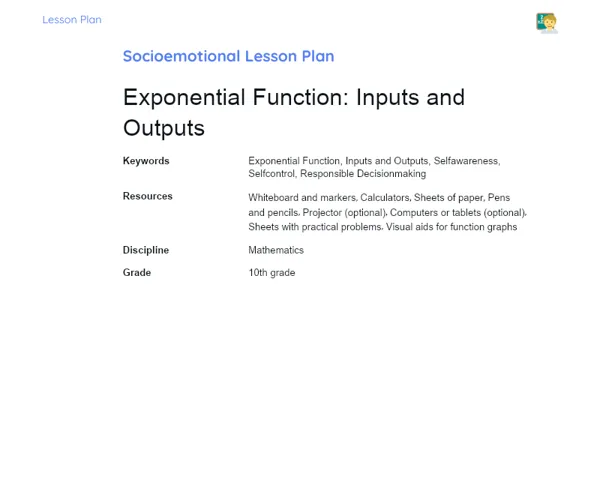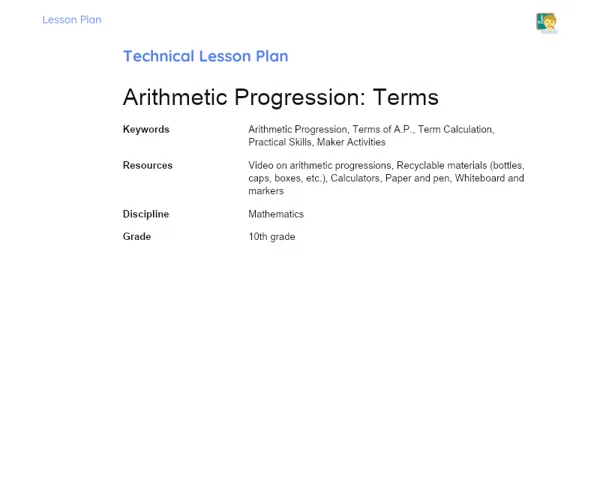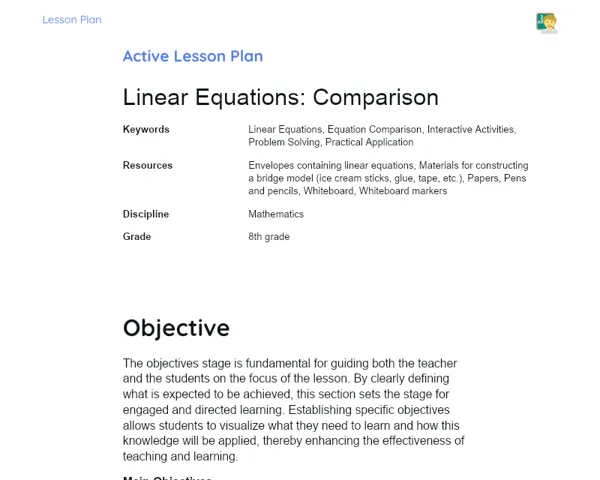Lesson Plan | Active Methodology | Compound Rule of Three Problems
| Keywords | Rule of Three, Inversion of Quantities, Practical Application, Critical Thinking, Engineering Problems, Interactive Activities, Group Collaboration, Reflective Discussion, Everyday Life and Mathematics, Analytical Skills |
| Necessary Materials | Maps of terrains with fuel efficiencies, Data on average speeds in different terrains, Information on quantities and flow rates of ingredients, Copies of practical exercises for each group, Paper, pens, and calculators for students, Projector or board for group presentations |
Premises: This Active Lesson Plan assumes: a 100-minute class duration, prior student study both with the Book and the beginning of Project development, and that only one activity (among the three suggested) will be chosen to be carried out during the class, as each activity is designed to take up a large part of the available time.
Objective
Duration: (5 - 10 minutes)
The objectives section of the lesson plan is vital for setting a clear learning path. By detailing specific and measurable objectives, students are informed about what they need to accomplish and how their progress will be assessed. This practice ensures that the lesson stays focused and productive, so students can effectively apply the knowledge they've gathered before.
Objective Utama:
1. Enable students to solve problems using the rule of three with multiple variables, particularly in cases where proportional quantities are inverted.
2. Enhance students' analytical skills to recognize and apply the concept of quantity inversion in various mathematical contexts.
Objective Tambahan:
- Stimulate critical thinking and curiosity in students through practical, real-world problems that necessitate the application of the rule of three.
Introduction
Duration: (20 - 25 minutes)
The introduction of the lesson aims to engage students by linking theoretical concepts they have previously encountered with practical, real-world contexts. By presenting scenarios rooted in daily life, students are encouraged to apply their knowledge in a hands-on manner, helping them see the importance of the topic in their own lives. This contextualization solidifies learning by illustrating the integration of mathematics in various activities and emphasizing the historical and modern significance of the rule of three.
Problem-Based Situation
1. Imagine an ice-cream factory that needs to figure out how long it will take to fill a 5000-liter tank using three hoses, each with different flow rates. Two hoses fill the tank in 3 hours, while the third, which is more powerful, takes only 2 hours.
2. Consider a situation where a construction team has to estimate how many days it will take to complete a project. Working collaboratively, they can finish in 8 days, but a new material could help them finish in just 4 days.
Contextualization
The rule of three is a robust mathematical concept that is relevant in everyday situations and practical problems across different sectors, including engineering, business, and logistics. For example, understanding how variations in production speeds influence total processing time or how differences in resource consumption impact final results are common applications of this rule. The rule of three has historical significance, as it was employed in ancient times to resolve trade and proportion issues, underscoring its enduring relevance.
Development
Duration: (75 - 80 minutes)
This stage encourages students to engage in practical and challenging scenarios that necessitate the direct application of the rule of three. Collaborating in groups allows students to converse and work together to tackle complex issues, reinforcing their understanding of theoretical content while honing communication and analytical skills. By selecting one of the outlined activities, students can employ their prior knowledge in realistic situations, boosting retention and comprehension of the material.
Activity Suggestions
It is recommended that only one of the suggested activities be carried out
Activity 1 - The Challenge of the Math Alchemists
> Duration: (60 - 70 minutes)
- Objective: Use the rule of three to tackle a real-world problem and grasp the significance of proportions in chemistry and day-to-day life.
- Description: Students will be split into groups of up to 5 and tasked with assisting an ancient guild of alchemists in creating a magical potion. This potion requires a blend of three mystical ingredients, each with varying strength proportions. They will apply the rule of three to calculate the precise amounts of each ingredient necessary to concoct a potion that cures a rare ailment.
- Instructions:
-
Divide the class into groups of up to 5 students.
-
Explain the challenge and introduce the mystical ingredients, stating their respective strengths and proportions.
-
Each group must calculate the required quantities of each ingredient for the ideal potion mixture using the rule of three.
-
Students should present their calculations and explain their choices.
-
Hold a class discussion to explore the different strategies and solutions proposed by the groups.
Activity 2 - The Engineers' Race
> Duration: (60 - 70 minutes)
- Objective: Employ the rule of three to address a resource optimization challenge in a practical and lively context.
- Description: Here, students take on the role of engineers in a racing team that needs to optimize fuel usage throughout a long-distance race. They must determine how much fuel to carry for each segment, accounting for differing efficiencies across various terrains and speeds.
- Instructions:
-
Form groups of up to 5 students, dubbing each group a racing engineering team.
-
Present maps that show different terrain segments along with their respective fuel efficiencies.
-
Students will leverage the rule of three to establish the optimal fuel amount for each segment by considering distance and anticipated speed.
-
Each group will explain their fuel strategy and how they applied the rule of three.
-
Facilitate a class discussion to review the different strategies and outcomes.
Activity 3 - The Mystery of the Lost Travelers
> Duration: (60 - 70 minutes)
- Objective: Enhance logical reasoning and apply math to resolve urgent, real-world challenges.
- Description: In this activity, students will adopt the roles of investigators attempting to solve the mystery surrounding the disappearance of a group of travelers. They will have information about the last spotted locations of the travelers and their average speeds across different terrains. The aim is to use the rule of three to estimate the travelers' whereabouts and devise an efficient rescue route.
- Instructions:
-
Split the class into groups of up to 5 students, with each group acting as a rescue team.
-
Provide the data on the last sightings along with the average speeds of the travelers in various terrains.
-
Each group must apply the rule of three to map potential routes and current positions of the travelers.
-
Draft a comprehensive rescue plan, detailing possible locations of the travelers and the resources required for the rescue.
-
Hold a discussion to assess the various scenarios presented by the groups and the strategies used in their calculations.
Feedback
Duration: (15 - 20 minutes)
The goal of this feedback stage is to deepen learning, encouraging students to articulate their knowledge and reflect on their problem-solving methods. Group discussions help pinpoint learning gaps and clarify any confusing ideas, while also fostering communication and teamwork skills. This time also allows the teacher to gauge student understanding, guiding future lessons and explorations of the content.
Group Discussion
Kick off the group discussion by inviting each team to share their insights and thought processes throughout the activities. Encourage them to talk about not just the solutions they found but also the hurdles they faced and how they overcame them. Pose questions like 'What was the most challenging aspect of utilizing the rule of three in your case?' and 'How did you organize your calculations to derive the solution?' to steer the chat and enhance student understanding.
Key Questions
1. What were the main challenges you encountered when applying the rule of three to the given problems?
2. How did the inversion of proportional quantities influence your calculation approach?
3. Was there any specific strategy or technique that eased the process for your group in arriving at a solution?
Conclusion
Duration: (5 - 10 minutes)
The conclusion phase aims to ensure that students have a clear and thorough understanding of what has been learned throughout the lesson. By summarizing the main points, we strengthen the connection between theory and practice and underline the significance of the knowledge for future applications. This recap serves to solidify understanding and ensures that students can apply what they've learned to real-life situations and new challenges.
Summary
In conclusion, we will recap the key concepts of the rule of three, emphasizing its application in everyday scenarios. We'll revisit the idea of inversion of proportional quantities and its impact on problem-solving. Students have had the chance to apply these principles in simulated situations ranging from production calculations to rescue strategies, showcasing the flexibility and importance of the rule of three.
Theory Connection
Throughout the lesson, we tied theoretical concepts to practice through engaging activities that simulated real and pressing situations. These tasks enabled students to apply prior theoretical knowledge in practical settings, reinforcing their comprehension and the utility of the rule of three. This approach not only facilitates understanding but also prepares students to leverage mathematical concepts in their future careers and personal circumstances.
Closing
Grasping the rule of three is crucial, as it serves as an essential mathematical tool across various professions while also helping develop analytical and critical skills. The ability to apply this knowledge in wide-ranging contexts gives students a distinct advantage both academically and in their careers.



